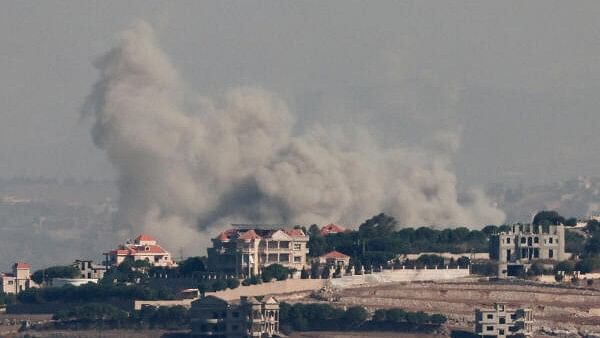
Smoke billows over southern Lebanon, amid ongoing hostilities between Hezbollah and Israeli forces, as seen from northern Israel, October 26, 2024.
Credit: Reuters Photo
Israel has multi-layered air defences against attacks by regional adversaries such as Iran, where military sites were hit by Israeli strikes on Saturday in the latest exchange in the escalating conflict between the Middle East rivals.
Israel said it was retaliating for Tehran's missile attack on Israeli targets on October 1. Israel has been honing its air defences since coming under Iraqi Scud salvoes in the 1991 Gulf war, in addition to receiving support from the US which said in October it had sent an advanced anti-missile system to Israel to support those defences.
Here are details of Israel's missile defences:
Arrow
The long-range Arrow-2 and Arrow-3 interceptors, developed by Israel with an Iranian missile threat in mind, are designed to engage threats both in and outside the atmosphere, respectively. They operate at an altitude that allows for the safe dispersal of any non-conventional warheads.
State-owned Israel Aerospace Industries is the project's main contractor, while Boeing Co is involved in producing the interceptors. On Oct. 31, 2023, Israel's military said it had used the Arrow aerial defence system for the first time since the outbreak three weeks before of the war with Hamas to intercept a surface-to-surface missile fired from the area of the Red Sea towards its territory. In September last year, Germany signed a letter of commitment with Israel to buy the Arrow-3 system for nearly 4 billion euros ($4.2 billion).
David's sling
The mid-range David's Sling system is designed to shoot down ballistic missiles fired from 100 km to 200 km (62-124 miles) away.
Developed and manufactured jointly by Israel's state-owned Rafael Advanced Defense Systems and the U.S. RTX Corp, formerly known as Raytheon, David's Sling is also designed to intercept aircraft, drones and cruise missiles.
Iron dome
The short-range Iron Dome air defence system was built to intercept the kind of rockets fired by the Palestinian Islamist movement Hamas in Gaza.
Developed by Rafael Advanced Defense Systems with U.S. backing, it became operational in 2011. Each truck-towed unit fires radar-guided missiles to blow up short-range threats like rockets, mortars and drones in mid-air.
Rafael says it delivered two Iron Dome batteries to the US Army in 2020. Ukraine is seeking a supply as well in its war with Russia, though Israel has so far only provided Kyiv with humanitarian support and civil defences.
A naval version of the Iron Dome to protect ships and sea-based assets was deployed in 2017.
The system determines whether a rocket is on course to hit a populated area; if not, the rocket is ignored and allowed to land harmlessly.
Iron Dome was originally billed as providing city-sized coverage against rockets with ranges of between 4 and 70 km (2.5 to 43 miles), but experts say this has since been expanded.
Laser-based system
Israel's interception systems cost between tens of thousands and millions of dollars to shoot down incoming threats. Israel is developing a laser-based system to neutralise enemy rockets and drones at an estimated cost of just $2 per interception.
US Thaad system
The US military said on Oct. 21 it had sent the advanced anti-missile system THAAD, or the Terminal High Altitude Area Defense system, to Israel.
THAAD is a critical part of the US military's air defences and is designed to intercept and destroy short-, medium-, and intermediate-range ballistic missile threats in their terminal phase of flight.